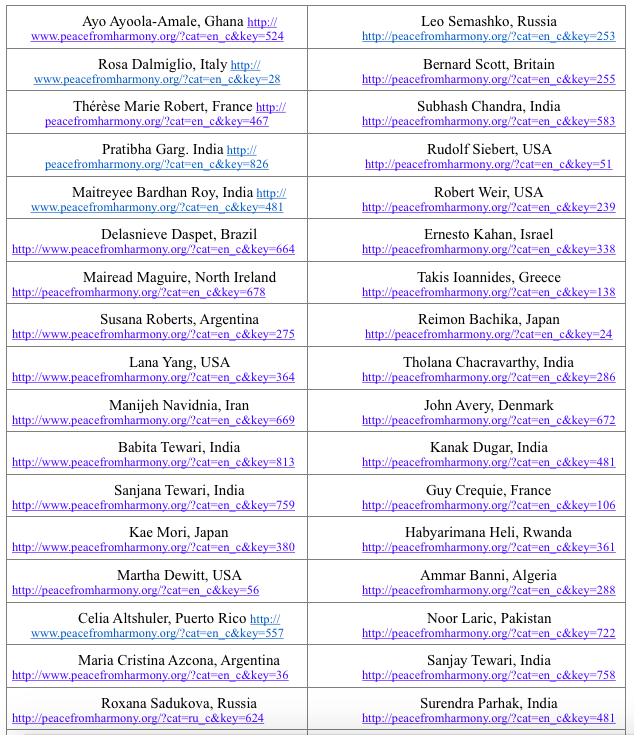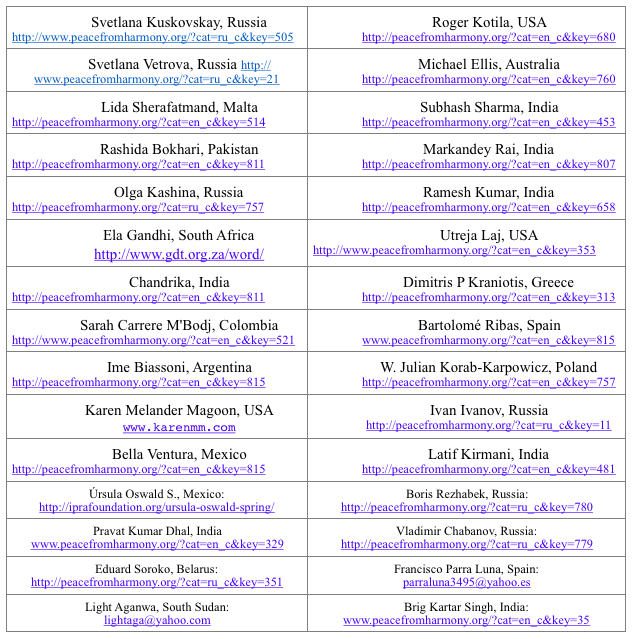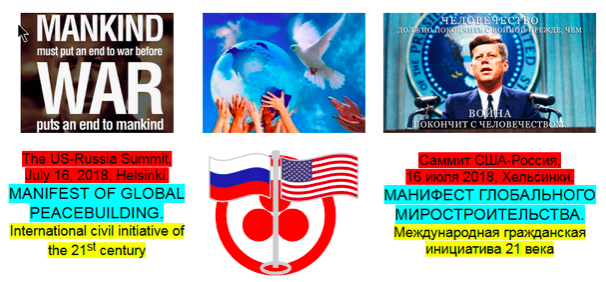The Great Peace Charter XXI. Resolution of the US-Russia Summit, July 16, 2018, Helsinki. The GHA and WGHA draft approved on July 8, 2018.

1. Emergency of “The Great Peace Charter” for the 21st-century
We, the undersigned 72 peacemakers from 27 countries representing more than 15 international peacemaking and humanitarian organizations, appeal to the leaders of the world’s most powerful nuclear powers with 96% of the stockpiles of all nuclear weapons: to the United States President – Mr. Donald Trump and the Russia President – Mr. Vladimir Putin with the proposal to take as the resolution of your Summit the fundamental for the world community of the 21st century, “The Great Peace Charter.”
This Charter will begin an unprecedented historical process for the liberation of humankind from wars and for the approval of its existential right to live without wars. Therefore, its spiritual and moral significance in the history of humanity will be no less than the significance of “The Great Charter of the Liberties”, 2015 for the affirmation of the universal value of freedom.
The world civil society, almost 8 billion people from more than 200 countries, demands and expects from you not the next peacekeeping cosmetics of the infinitely growing militarism, putting humanity on the verge of “shameful self-destruction of humankind” (Helena Roerich), but a fundamental peacebuilding solution, The Great Peace Charter, which excludes the repetition of the last century – the most deadly and devastating in the human history, full of countless conflicts, casualties, suffering and monstrous war crimes (Kofi Annan).
From the “point of no return” for the humanity self-destruction, which is now 100% prepared, only the light push of the nuclear trigger separates, the responsibility for which lies entirely with the governments of the United States and Russia.
The constantly growing threat of self-destruction of humanity tramples the first and fundamental human and humanity right to life, making it ever more chimerical and questionable. The growth in volumes and, above all, the effectiveness of weapons, especially nuclear and similar, proportionally reduces the existential level and probability of the survival for humankind on the planet as its noosphere.
The perspective of an endless intensification within continuous arms race in this planetary sphere turns it from “reasonable” into “insane sphere”. It is alone on the planet irresistibly aspiring to self-destruction for more than a century, practicing in the world wars and steadily raising their “rating” both in social production, in the public consciousness and in power.
Therefore, the complete and shameful, 100% stand-to the nuclear suicide of humankind, primarily by the hands/nuclear bombs of the US and Russia, absolutely determines the emergency of The Great Peace Charter on the verge of this irretrievable existential abyss. The responsibility for ignoring humanity survival and the extreme necessity of a similar rescuing solution lies entirely on the nuclear superpowers leaders.
2. The Summit and its decision center
What is the key meaning and the center of the Summit decision? It was brilliantly formulated by John Kennedy at the UN Session 55 years ago as a self-evident absolute truth of the present: “Mankind must put an end to war before war puts an end to mankind.”
However, unfortunately, there are still unanswered questions arising from this truth: “Who, How, at What Level and When will end the war and feeding its militarism?“
The historic mission of the leaders of the nuclear superpowers is to rise to the level of John Kennedy’s peacemaking thinking, to continue and enrich it as a synthesis of the 8 greatest peacemaking covenants and initiatives of the past, developing the Kennedy truth, and yours own unique contribution to the organizational global governance of its implementation in the 21st century.
Only in this case you will make yourself and your nations “again great”, the memory of which humanity will preserve forever as world leaders who changed the course of history from war to peace, “from the arms race to a peace race” (Martin Luther King).
3. Integration of peacemaking covenants and initiatives
The eight great peace covenants and initiatives of the 20th and 21st centuries, which constructively develop Kennedy’s truth, are:
1. Program of general and complete disarmament in the UN, 1959: USSR/Russia,
2. “Peace can not be achieved through violence, it can only be attained through understanding” [science]: Albert Einstein,
3. “We shall require substantially new manner thinking if mankind is to survive”: Albert Einstein,
4. We must “shift the arms race into a peace race”: Martin Luther King. (Are the US and Russia leaders able to rise to the level of King and to realize this historic “shift” at least in the format of an agreement of intentions for the near future?),
5. Peace Departments in governments: an ancient American idea, not yet embodied,
6. Multipolar harmonious world order: the foreign policy idea and the course of Russia,
7. Reforming the UN, international law and global governance: a common understanding of this need,
8. Sociocybernetic “Global Peace Science” of international origin in the early 21st century, revealing the genetics of global peace in the structural harmony/balance of the spheres of world social production. This science systematically and holistically integrates these great peacemaking covenants and initiatives of the 20th and 21st centuries. It ensures the realization of “peace through understanding,” the exclusion of violence, militarism and weapons as the main threat to security and the achievement of assured security for all nations. This all “will end the war” and eradicate it as an obsolete institution.
The Great Peace Charter undoubtedly requires a similar, generally acceptable scientific platform and its joint scientific development, which the US and Russia could begin to initiate their cooperation instead of their confrontation.
4. Large-scale and long-term “Roadmap” for global peacemaking
The main contribution of world leaders to the understanding of global peacemaking for the 21st century could be its principled, large-scale and long-term “Roadmap”, based on the synthesis of peace covenants and responding, at least in the first approximation, to the questions: “Who, How, at What Level and When will end the war and feeding its militarism?“
The key roadmap lighthouses:
1. The ultimate goal, “end the institution of war”: universal complete disarmament and guaranteed nonviolent security as a conscious global peace on the socio-genetic level of the structural harmony of the spheres within world social production during 50 years of the 21st century,
2. The primary goal for the next 5-10 years is nuclear disarmament, “nuclear zero”, requiring for all nuclear weapons immediate taken off hair trigger alert and its reduction by 20-10% annually under the control of the IAEA. This is the first practical goal for nuclear leaders, which the USA and Russia ones could and should initiate. This is their priority responsibility before their peoples and humanity in a whole.
3. Orientation to conscious harmonious economic relations, excluding world “trade and sanctions wars” and contributing to the reduction of political tension instead of its aggravation.
4. Determination of the time and extended format of the next “Global Peace Summit” with the participation of all 9 nuclear powers, the EU, the UN and the world civil society represented by the most deserved peacemaking non-governmental organizations working for at least 10 years, uniting peacemakers from at least 30 countries and possessing fundamental peacebuilding ideas / concepts, fixed in publications. This format is dictated by the peacemaking grandiose mission in the 21st century defined by The Great Peace Charter and ensures democracy in its adoption and fulfillment.
Recognition in the Roadmap of the USA and Russia leaders of at least these grandiose peacemaking landmarks of the 21st century will provide to you and your peoples with the place of historical peace builders of the third millennium of world human history, determining its powerful peacemaking breakthrough and the turning-point from traditional militaristic trend.
Recognition of these ultimate goals will make it possible to formulate the strategy and tactics of achieving the entire cluster of the numerous intermediate goals and tasks of the 21st century within peacebuilding process as a new global movement of pacification.
This will be a movement along the road to peace “through understanding” in the global peace science; it will be a “shift from the arms race to a peace race” and to a new non-militaristic thinking; it will be time for institutions in the governments of the “Department of Peace” responsible for organizing, managing, implementing, monitoring and control of these goals achievement; it will be the UN and global governance reform, subject to these anti-militaristic goals; this will require an answer to the key question: WHO, which social force and which actors of social production and geopolitics can guarantee the achievement of these goals.
To answer this question, it takes a long time of scientific peacemaking restructuring of public consciousness through the appropriate education of new generations and the enlightenment of adult generations.
Of course, in the peacebuilding roadmap, the partial but acute problems of Syria, Iran, Donbas, North Korea and the like must find a place. However, their decision in the context and on the common platform of “The Great Peace Charter” will be much more effective and faster than without it. Otherwise, partial questions will suppress the horizon and dream of global peace for humanity.
So we can see the broad contours of the peacebuilding roadmap in the 21st century.
5. Resolution of the US-Russia Summit and its alternatives forecast
The squeeze of the proposed ideas of 1-2 pages, not more, the text of the US-Russia Summit Resolution will be The Great Peace Charter as the long awaited and keenly necessary on the brink of nuclear suicide solution.
This will be the most dignified and highly responsible and ethical Resolution in relation to humanity as a whole and in relation to the USA and Russia national interests, but will not be confined to them. This resolution will accentuate the deep commonality of the USA and Russia basic values, which was repeatedly emphasized by their leaders, for all their differences.
Another, almost equal, final alternative maybe the Resolution of cosmetic propaganda significance, filled with the pathetic beautiful words about “global security, peace and responsibility,” but emphasizing the value differences and instrumental approaches of the two countries preserving for this the inviolable institutions of war, militarism and the factual arms race. Which of the alternative Resolutions will win will be visible at the summit end.
6. Instead of an epilogue. The foundations of hope
We, the peacemaking leaders of the world civil society, hope that both presidents will find enough courage and political will to accept the first value-based Resolution. Despite all the differences in personalities, cultures and countries they represent, they have two important electoral potentials.
First, they both talked about “harmonious or coherent foreign policy” and second, both formulated paradigms of global peace in their election platforms, in which they proclaimed “common ground” and “shared interests” of the parties within the common goal: “our goal is peace and prosperity, but not war and destruction” (Trump): see this.
***
The project organizational part.
The proposed international civil initiative of peacemaking and humanitarian organizations is:
The GHA 65th and the WGHA 4th Project jointly with other international organizations. It was launched on June 29, 2018, when it became known about the US-Russia Summit. Approved on July 8, 2018. It is open for support and signing indefinitely, not only for this, but for all subsequent summits, if left unattended. We will compare the adopted Summit Resolution with our proposal.
“The Great Peace Charter” project coauthors: 72 peacemaking leaders (list below) from 27 countries and more than 20 international peacemaking organizations:
Nobel Peace Laureates:
Mairead Maguire, Nobel Peace Prize Laureate 1976, stopped the terror in Belfast, Northern Ireland, Community for Peace People, see this
Prof. John Scales Avery, Nobel Peace Prize Laureate (shared 1995 award), Chairman of the Danish Peace Academy, Copenhagen, Denmark, see this
International Physicians for the Prevention of Nuclear War, Nobel Peace Prize 1985, Ernesto Kahan, Israel: see this
International peace organizations:
- Global Harmony Association, Leo Semashko, Julia Budnikova, Nina Novikova, Russia
- Women’s Global Harmony Association, Ayo Ayoola-Amale, Ghana
- Women’s International League for Peace and Freedom, Ayo Ayoola-Amale, Ghana
- International Center for Sociocybernetics Studies, Bernard Scott, Britain
- Global Peace Foundation, Subhash Chandra, India,
- International Association of Educators for World Peace, Lana Yang, USA
- Russia and America Goodwill Association, Vladislav Krasnov, USA
- Center for Humanistic Future Studies at Michigan University, Rudolf Siebert, USA
- World Constitution and Parliament Association, Roger Kotila, USA
- A People’s Campaign for Peace in the United States, Robert Weir, USA
- Community for Peace People, Mairead Maguire, Nobel Peace Laureate, North Ireland
- World Wide Peace Organization, Maria Cristina Azcona, Argentina
- Society “ONE WORLD – ONE HARMONY DREAM”, Rosa Dalmiglio, Italy
- Danish Peace Academy, John Avery, Denmark
- International Physicians for the Prevention of Nuclear War, Nobel Peace Prize 1985, Ernesto Kahan, Israel
- Gandhi Development Trust, Ela Gandhi, South Africa
- ESTIA NEW SMYRNA FOUNDATION, Takis Ioannidis, Greece
- Global Peace Centre, Michael Ellis, Australia
- International Peace Research Association, Ursula Oswald, Mexico
- Noospheric Research and Development Institute, Boris Rezhabek, Russia
- IESL Association, Brig Kartar Singh, India
- Magadh University, Pravat Kumar Dhal, India
And others
The GHA peace proposals and initiatives for past summits, which detail the separate aspects of the proposed “The Great Peace Charter”:
- Global Harmony as Guarantor for World Security and Nuclear Zero, May 2009: see this,
- Global Harmony International Treaty for Nuclear Disarmament, May 2009: see this,
- General and Complete Disarmament in 50 years on the Basis of Global Harmony through the ABC of Harmony. GHA Constant Petition to the UN. GHA 37th project. Started: August 31, 2012: see this
- BEFORE THIRD WORLD WAR. Peace and Disarmament from Harmony. New World Peace Movement for the 21 century. GHA 38th Project. Started: September 24, 2012: see this
- Monitoring: Dynamics of Peace and War Priorities in the World Public Consciousness. Approved by GHA on January 17, 2014: see this
- Global Peace Science. 2016: see this
- Russia – USA: Global Peace Cooperation. The 52nd GHA project. Approved by the GHA on September 5, 2016: see this
- PUTIN – TRUMP: Two paradigms of global peace. GHA Open Letter, February 1, 2017: see this
- Global Peace Science Agenda for the UN, UNESCO, G20 and EU. June 5, 2017: see this
- The UN of Harmony and Global Peace Replacing the UN of Disharmony. Sociocybernetic Model of Spherons’ Global Harmonious Governance (SMSGHG) at the UN level. Approved on November 16, 2017: see this
- Global Peace Science for G20-2013 and Humanity: see this
- Global Peace Science for G20-2017 and Humanity: see this
- Spherons’ Global Peace Genetics. GHA and WGHA MESSAGE on the Global Harmony Day, June 21, 2018: see this
- USA-RUSSIA Summit. The Great Peace Charter for the 21st century. 08-07-18: see this
And others
The leaders-coauthors list
72 peacemakers from 27 countries: Australia, Algeria, Argentina, Belarus, Brazil, Britain, Colombia, Denmark, Ghana, Greece, France, Israel, India, Iran, Malta, Mexico, Northern Ireland, Pakistan, Poland, Puerto Rico, Russia, Rwanda, South Africa, South Sudan, Spain, USA, Japan
Banner
By Mairead Maguire, John Scales Avery, and Dr. Leo Semashko
The original source of this article is Peace From Harmony
The 21st Century




